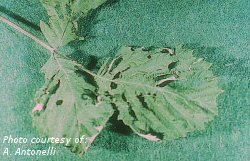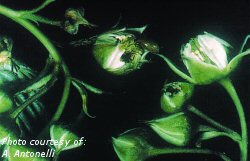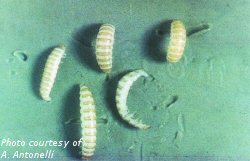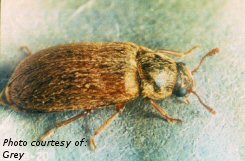Raspberry Fruitworm (Byturus Bakeri)

Raspberry fruitworm feeding damage to leaves

Raspberry fruitworm damage to flower buds

Raspberry fruitworm larvae

Adult raspberry fruitworm beetle
Host Plants And Distribution
In North America this insect prefers raspberries but may also infest loganberries. This species occurs across the Prairie Provinces. Other closely related species occur in other regions of Canada and the United States.
Biology
Adults of the raspberry fruitworm are small (4 mm) yellowish-brown, oval shaped beetles. The adults overwinter in the soil, emerging in spring at the same time as raspberry leaves begin to emerge. Adult feeding begins along the midrib of partially folded leaves. Later feeding occurs between the blossom buds, and as the buds separate, the insect attacks the blossom buds, making large entrance hole to feed on floral parts. Eggs are laid on unopened blossom buds. Upon hatching, the larvae feed initially on the flowers and later burrow into the developing fruit. Feeding by larvae goes on for 30-40 days. Larvae are whitish-yellow and about 7 mm long when mature. At maturity (late July) the larvae drop to the ground, burrow into the soil and pupate. There is one generation per year.
Symptoms And Damage
Early season symptoms are indicated by longitudinal holes in the foliage, leaving a tattered appearance. This injury is caused by adult feeding. Excessive feeding by adults may cause leaf skeletonization. Numerous adult beetles may destroy entire flower clusters. Larval tunnelling through receptacles can cause loosening of berries so that they fall off before harvest. Contamination of harvested fruit by larvae can be a serious problem. Larvae cause more problems than adults.
Scouting Techniques
Look for long holes in leaves and small holes in flower buds. Visual inspection of foliage for characteristic longitudinal holes caused by adult feeding will give an idea of population levels.
Economic Thresholds
No economic thresholds have been established for this insect. Remember that to justify chemical application, the cost of fruit lost to insect infestation must exceed the cost of chemical and application. Spot treatment may be a viable alternative if infestations are local within an orchard.

